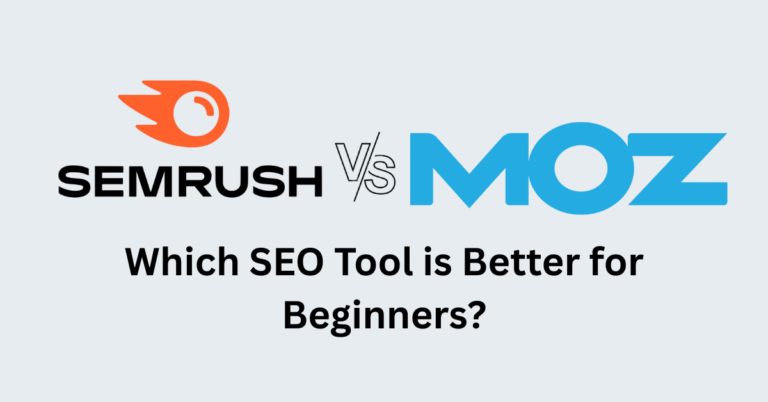Let’s be real—when you’re starting your SEO journey, tools like SEMrush can feel like a spaceship dashboard. So many features, tons of data, endless buttons… and that pricing! You might be wondering: Is SEMrush even worth it for someone just starting out?
SEMrush is one of the most talked-about tools in the digital marketing world. It’s trusted by bloggers, marketers, and businesses looking to grow their traffic and online visibility.
In this honest SEMrush review, I’ll walk you through SEMrush’s features, pricing, pros, and cons—all from a beginner’s lens. By the end, you’ll know whether SEMrush is the right SEO tool for you or just another shiny object for beginners.
Table of Contents
What is SEMrush?
SEMrush is an all-in-one digital marketing toolkit that helps you grow your website traffic through SEO, PPC, content marketing, and competitive research.

Originally launched as a simple keyword tool, it has now evolved into a powerful platform used by over 10 million professionals, including agencies, freelancers, bloggers, and marketing teams.
Here’s what you can use SEMrush for:
- Discover high-performing keywords.
- Spy on competitor strategies.
- Run in-depth site audits.
- Track search engine rankings.
- Analyze backlink profiles.
- Get SEO writing assistance.
All of these features are aimed at one goal: making your website more visible on Google and other search engines.
Top SEMrush features beginners should know:
SEMrush is incredibly feature-rich. It’s loaded with so many tools that trying to cover them all in one review would be overwhelming—especially if you’re new to SEO.
So instead of listing everything, I’ll focus on the 6 key features that actually matter for beginners. These are the tools that can help you get started with keyword research, content writing, technical SEO, and more—even if you’ve never done SEO before.
Here are the 6 beginner-friendly features we’ll explore in this section:
- Keyword Magic Tool
- keyword overview
- Site Audit
- Position Tracking
- Backlink Analytics
- Organic Research
We’ll also touch briefly on a few other helpful features, just so you know what’s available, but we’ll keep the focus on what’s most useful when you’re just getting started.
Once you sign up for SEMrush, you’ll land on your main dashboard—a central place where you can access tools like keyword research, site audits, backlink analysis, and more.

As you can see in the image above, SEMrush makes it easy to start exploring the most important SEO features right from the beginning—even on a free trial.
Depending on the plan you choose, you can manage between 5 and 40 websites as separate projects. All tools are neatly listed on the left-hand sidebar, and most of the key features you’ll use—like keyword research and audits—are under the “SEO” section.
Keyword Magic Tool
If you’ve ever stared blankly at Google wondering what keywords to target, you’re not alone. SEMrush’s Keyword Magic Tool takes that confusion away—it gives you thousands of keyword ideas in just a few seconds.
Just enter a simple seed keyword like “healthy recipes,” and the tool instantly generates a long list of related terms.
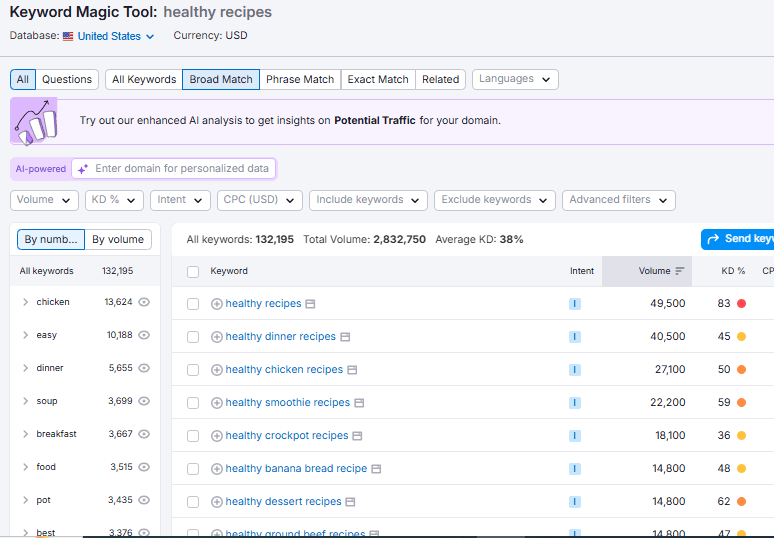
You can then filter and sort the results by key metrics such as:
- Search volume—how often people search for the keyword
- Keyword difficulty (KD)—how hard it is to rank
- Search intent—is the keyword informational, navigational, or commercial?
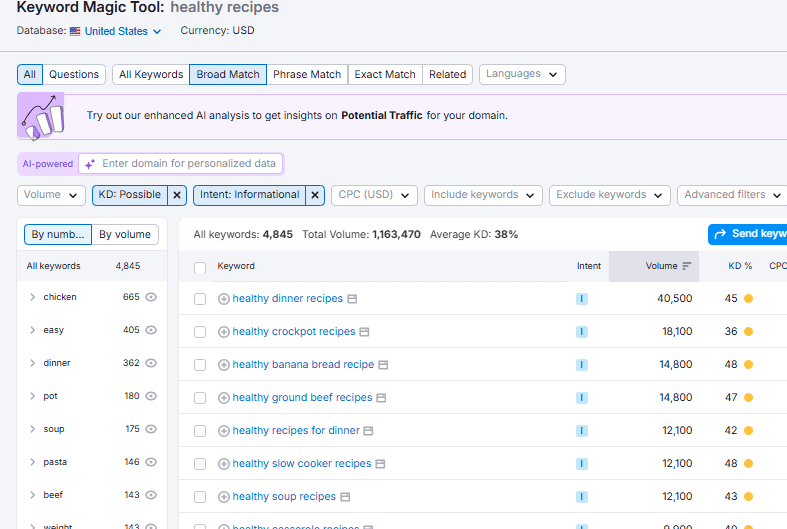
These filters help beginners quickly spot low-difficulty keywords that match their content goals—so you’re not wasting time on topics you can’t rank for.
In short, the Keyword Magic Tool is a beginner-friendly way to discover high-potential keywords that can actually bring traffic to your blog or website.
Keyword Overview
SEMrush’s Keyword Overview Tool is a great way to analyze a single keyword in detail — especially when you’re not sure if it’s the right one to focus on.
Let’s take the example “weight loss.” I entered it into the Keyword Overview tool, and here’s what SEMrush revealed.

You’ll instantly see key stats like:
- Search volume – how many people search this each month.
- Keyword difficulty (KD) – how hard it is to rank for.
- Search intent – what users are hoping to find.
- Trend graph – is it getting more or less popular?
- Global volume – how it performs worldwide.
Scroll down to the SERP Analysis section, and SEMrush will show you a list of the top-ranking URLs for your keyword.
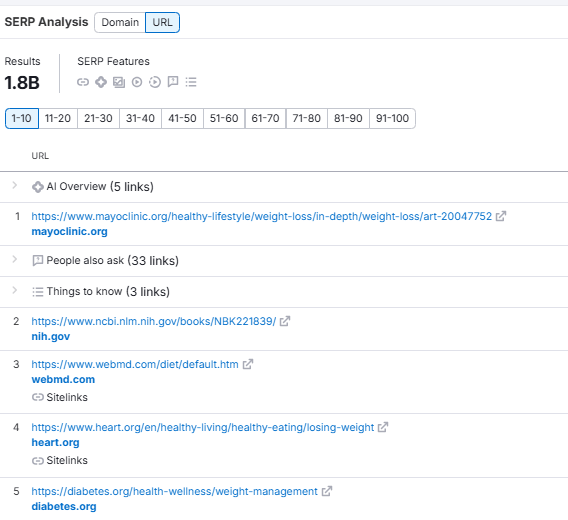
Even though it doesn’t show extra details like authority score or backlinks on the free plan, this quick view still helps you understand what kind of content is already ranking — which is super useful when planning your own blog post.
If you upgrade to a paid plan, you’ll unlock deeper insights like domain authority, referring domains, and backlink profiles to better assess your competition.
But here’s where it gets even more useful: SEMrush also suggests keyword variations, related questions, and content ideas.

This part helps you uncover long-tail keywords and popular questions people are already searching for — a huge help when planning blog content or article outlines.
Site Audit
SEMrush’s Site Audit tool is one of the most valuable features for improving your website’s overall performance. It crawls through all the pages on your site and uncovers SEO issues that could be holding you back from ranking well on Google.
What Does the Site Audit Check?
Once the audit is complete, you’ll get a detailed report highlighting issues like:
- Duplicate content
- Broken links
- Slow page speed
- Missing meta descriptions
- Crawlability errors
- HTTPS/SSL issues
Each issue is labeled as either:
- Errors (high priority)
- Warnings (medium)
- Notices (low)
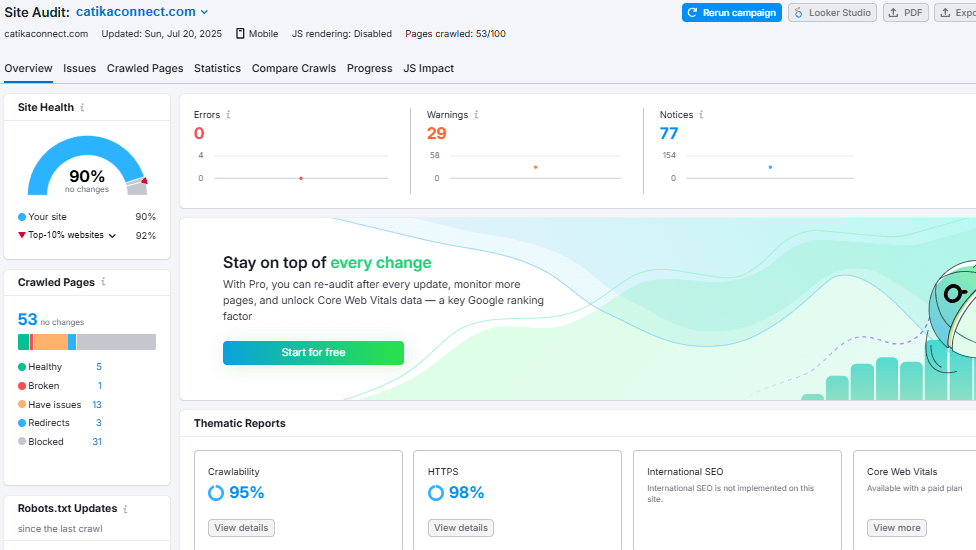
Issues are categorized as ‘errors’, ‘warnings’, or ‘notices’ based on how important they are. This can help you prioritize your SEO efforts.
This helps you understand what to fix first for the biggest SEO impact.
Track Progress Over Time
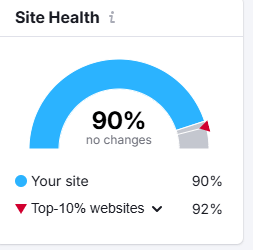
You’ll also get a Site Health Score, which shows how your site is performing overall. It’s a simple percentage, so you can easily track improvements as you fix more issues over time.
And if you’re just getting started with SEO, this tool gives you a clear roadmap to clean up your site and build a solid foundation.
Position Tracking
Want to know if your SEO efforts are actually working? That’s where SEMrush’s Position Tracking Tool shines.
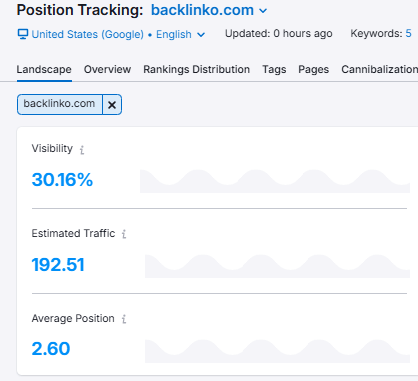
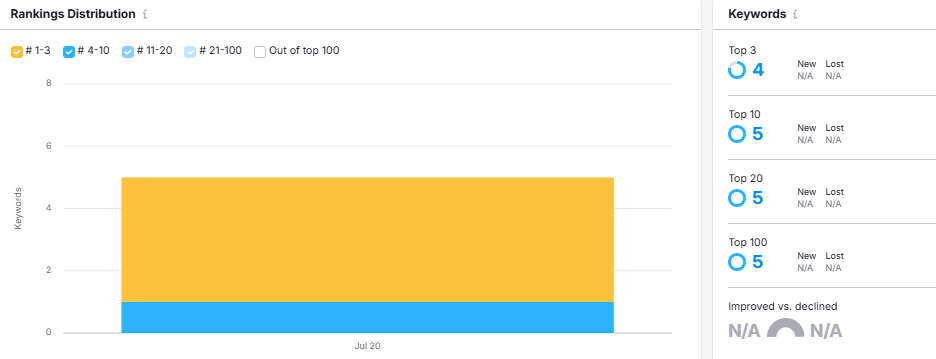
This feature lets you monitor how your website is ranking for specific keywords over time—daily updates included.
You just enter the keywords you want to track, and SEMrush shows you your current position. Plus, it lets you:
- Compare mobile vs desktop rankings, which is super important with Google’s mobile-first indexing.
- Track rankings based on location, making it perfect for bloggers and businesses doing local SEO.
- Visualize your progress over time through helpful charts—like visibility score, keyword movement, and ranking distribution.
Whether you’re targeting a few blog keywords or hundreds across pages, this tool helps you clearly see what’s working and what needs improvement.
Backlink Analytics
Backlinks are like votes of trust from other websites. The more high-quality backlinks you have, the more search engines see your site as authoritative.
SEMrush’s Backlink Analytics tool helps you analyze both your own backlink profile and your competitors’—so you can understand where you stand and what needs improvement.
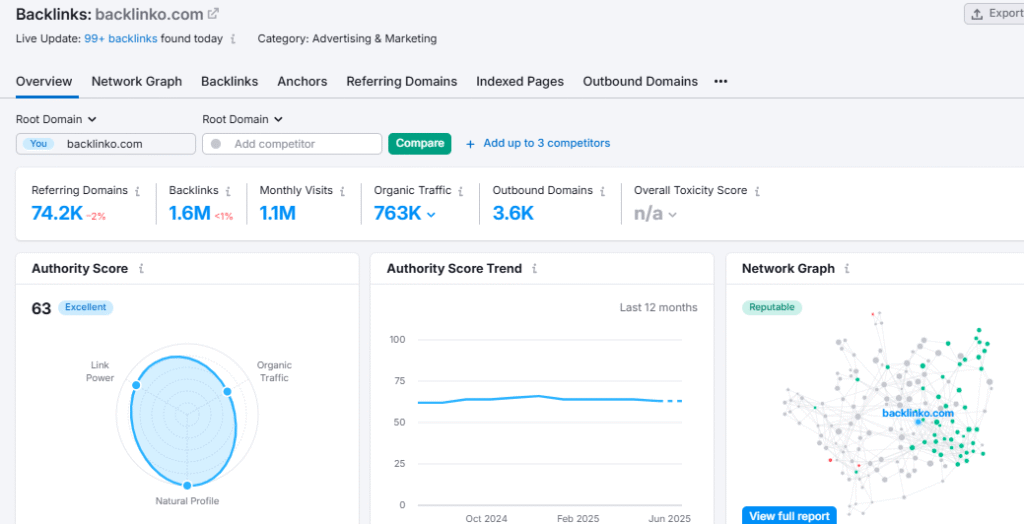
Here’s what you’ll discover in this report:
- Referring Domains – See how many unique websites are linking to your content
- Authority Score – Get a quality score for your domain or your competitor’s
- Follow vs No-Follow – See which links actually pass SEO value.
- Top Anchors – Know what text people are using to link to your site.
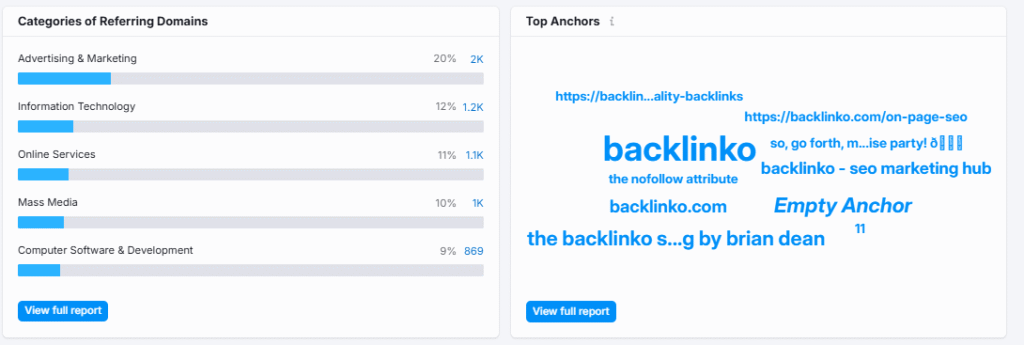
Competitor Backlink Gap
Want to know who’s linking to your competitors but not you?
The Backlink Gap tool shows you just that — helping you find new opportunities to build powerful links by reaching out to the same sources.
Toxic Backlinks and Disavow Help
Not all backlinks are good. Low-quality or spammy links can harm your SEO. SEMrush will:
- Highlight toxic backlinks
- Suggest how serious the risk is
- Allow you to create a disavow file (ready to upload to Google Search Console)
This tool takes the guesswork out of link building and helps you focus only on quality.
Organic Research
SEMrush’s Organic Research tool shows you how much traffic a website gets from Google — and what keywords are bringing in that traffic.
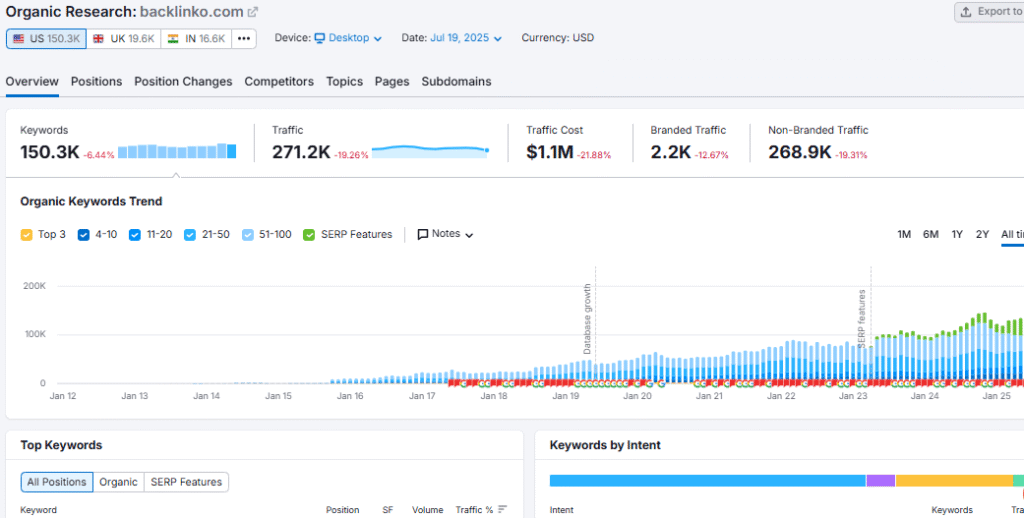
Just enter a website (even your competitor’s like one you see above), and you’ll see:
- Estimated monthly organic traffic
- Keywords that are ranking
- How traffic changed over time
For beginners, this is one of the best ways to get content ideas. Instead of guessing what to write about, you can look at what’s already working for similar websites — then create even better content.
Even if you’re starting from zero, this tool helps you learn fast by showing you:
- What kind of topics are performing well
- What keywords are driving traffic
- How big websites are ranking and growing
It’s a smart way to plan your SEO strategy — without needing to be an expert.
Other SEMrush Features You Might Want to Explore later:
We’ve already covered the most beginner-friendly features in detail, but SEMrush has a lot more going on. Even though we didn’t dive deep into all of them, here’s a quick overview of other tools you’ll come across in the dashboard:
- Domain Overview: Gives you a full snapshot of any website’s traffic, authority, backlinks, and top keywords. Great for spying on competitors — or yourself — once you’ve got more content.
- SEO Content Template (Pro plan required) : Helps you create optimized content by showing what’s working for competitors on your chosen keyword.It recommends things like word count, related keywords, and readability tips.
- On-Page SEO Checker: analyzes your published pages and gives specific SEO suggestions, like fixing missing tags or improving content structure. A great next step once your blog has a few live posts.
- Keyword Gap & Backlink Gap: Compare your site with competitors to find keywords and backlinks they’re ranking for — but you’re not. A smart way to uncover growth opportunities.
- Backlink Audit Tool : helps you find and disavow toxic backlinks that could hurt your rankings. Very helpful if your site grows bigger or gets hit with spammy links.
- Advertising Toolkit : Useful if you run Google Ads. It shows paid keywords, ad copies, competitors’ PPC strategies, and helps improve your ad performance.
- Content Audit : Once you’ve written many posts, this tool helps you audit under performing content. It even connects with Google Analytics and Search Console for smarter decisions.
- Market Explorer : provides insights into any industry’s audience behavior, market trends, and top competitors. Ideal if you want to understand your niche on a deeper level.
- Listing Management (Local SEO): Perfect for local businesses. It helps you manage and distribute your business info across 70+ directories to improve local visibility.
- Social Media Toolkit : Plan, schedule, and track your social media posts across platforms — all from SEMrush. Great for bloggers and marketers managing content across multiple channels.
Pros and Cons of Using SEMrush
Now that we’ve gone through the key features, let’s quickly look at what SEMrush does really well—and where it might fall short, especially if you’re just starting out in SEO or blogging.
Pros
- All-in-one SEO platform: Semrush gives you access to tools for keyword research, backlink tracking, site audits, and more—all in one place. No need to jump between different platforms.
- Trusted and accurate data: Whether you’re checking keyword volume or analyzing backlinks, SEMrush gives reliable data that helps you make smarter decisions.
- Huge keyword and backlink databases: It has one of the largest keyword and backlink collections out there, so you’re rarely short on ideas or research material.
- Constant improvements: SEMrush is always adding new features and refining old ones, which keeps you ahead of SEO trends.
- Free trial available: Not sure if it’s right for you? You can try it free for 7 days before making a decision.
Cons
- It’s a bit pricey: The cost can be high for beginners or bloggers just starting out. You’ll need to decide if it fits your current budget.
- Overwhelming at first: With so many tools in one dashboard, SEMrush can feel confusing. But once you spend time with it, it starts to make sense.
- Data is based on Google only: If you’re looking for data from Bing, YouTube, or other platforms, SEMrush won’t give you much. It’s very focused on Google.
- Traffic estimates aren’t always exact: The numbers are helpful, but not 100% accurate. Use them as a guide—not final truth—when making SEO decisions.
Semrush Pricing
SEMrush isn’t the cheapest SEO tool out there, but when you look at what you get, the price actually makes a lot of sense. With 50+ tools, huge data access, and features for SEO, content, PPC, and social media, it’s truly an all-in-one platform.

Let’s break down their pricing in a simple way so you can figure out what’s best for you.
Pro Plan – $139.95/month:
Perfect for bloggers, freelancers, or anyone just starting out. You’ll get access to most core tools, and you can manage up to 5 projects, Track 500 keywords daily, Run 10K results per report, Crawl up to 100K pages/monthn.
It doesn’t include advanced tools like content templates or historical data, but it’s enough to grow your site.
Guru Plan – $249.95/month
Ideal for small businesses or growing teams who need more data and tools. You can Up to 15 projects, 1,500 keyword tracking, 30K results per report , Includes Content Marketing Toolkit like SEO Writing Assistant, SEO templates, and historical data.
If you’re scaling or managing multiple sites, this is the sweet spot.
Business Plan – $499.95/month
Designed for big brands, agencies, or enterprises. You can Up to 40 projects, 5,000 keyword tracking, 1 million page crawls, Includes API access, Product Listing Ads, and advanced reporting.
This is the top-tier plan with everything SEMrush offers.
What About Add-ons?
SEMrush also has add-ons for even more power:
- Listing Management – For local SEO ($20–$40/mo) .
- Trends (Market Explorer + Traffic Analytics) – $200/mo.
- Agency Growth Kit – $150/mo.
- ImpactHero (AI tool for content) – $200/mo.
Not Sure If It’s Worth It?
No problem. You don’t need to decide right away. You can test SEMrush with limited free access — perfect if you’re just curious or starting small.
My Final Opinion: Is SEMrush Worth It ?
If you’ve made it this far, you’re probably still wondering — is SEMrush really worth the price and hype?
Here’s my honest take: It absolutely is — if you’re serious about growing online.
SEMrush is more than just an SEO tool — it’s like your personal marketing assistant. From finding the right keywords to checking your site’s health and even ethically spying on competitors, it covers almost everything.
For beginners, it might feel a bit overwhelming at first. But the great part? You don’t have to master every tool right away. Just focus on what you need most — like keyword research or site audits — and grow from there.
What I love is how SEMrush takes the guesswork out of SEO. It gives you clear data, smart suggestions, and step-by-step insights to improve your site. Even if you’re new to SEO or blogging, this tool gives you a strong foundation to build on.
So yes, it’s worth it — especially if you want to stop guessing and start making smarter decisions.
Still unsure? Try their free plan first and see how it fits your goals before committing.

